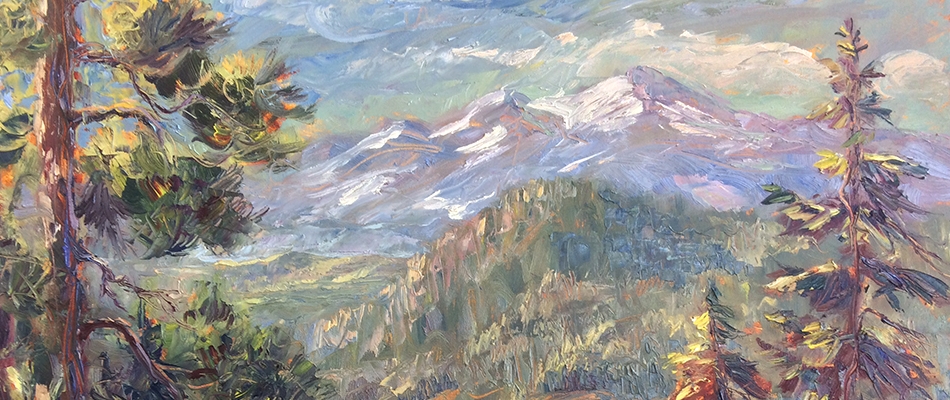Mad Dogs and Englishmen
David Yapp
Shoo Fly Road to Dark Canyon Road to Light Canyon Road. With each change in nomenclature the road becomes progressively more rutted and narrow as I descend into the dark, pine-clad canyon.
I eventually arrive at the path that leads up to the house, which will be the subject for my next oil painting. A live oak, some pines, and an old century plant create a pleasing foreground to the house beyond—a two-story, fourteen-sided, folly, reminiscent of a Tuscan hilltop villa. The morning sun illuminates its many sides like the facets of a diamond. A swathe of lavender encircles its base.
I walk around the perimeter of the hill on which the house is situated. Ultramarine lupins flank the brow of the ridge that rapidly descends into a broad forested canyon. Digger pines cling to the sides of the canyon framing a bend in the American river fifteen hundred feet below. The faint, distant whisper of the river’s surging power, like static white noise ascends up to where I am standing. Secure in it’s preeminence, the river revels in its sun-gilded glory.
I ascend the stairs of the house and greet Barry and Donna. After a cup of coffee, I make my way down the path and set up my painting gear. A little later, carrying an old white metal and canvas chair, Donna joins me to chat as I paint.
The morning continues uneventfully as I paint, interspersed with the back and forth of our conversation. Around midday Donna returns to the house to prepare lunch. Left alone with my paints and brushes I attempt to encapsulate the beauty of this Italianate folly and the landscape that surrounds it.
“Rroughh, rroughh,” I am abruptly interrupted and turn round to see two oversize Pit bull-like canines, one brindle, one tan, facing me. Evidently, some imaginative fellow had decided that breeding Pit bulls crossed with Great Danes would be the most splendid idea to terrorize the local community.
“Rroughh, Rroughh.”
“Go home, go home.” I command in my most authoritative voice; my British accent ringing out across the California high country. For a few seconds the dogs are silent, as if bewildered by this strange non-native tongue; then, nonplussed, they continue barking in unison. They have no intention of circumnavigating this artistic obstruction en-route home.
This interchange continues back-and-forth for several minutes:
“Rroughh, Rroughh.”
“Go home, . . . go home!”
Eventually, from the house, Donna comes striding down the path, bear horn in hand.
“Shoo, shoo,” bhlaaaaahh, bhlaaaaahh, “shoo!”
Eventually after several blasts of the bear horn and expressive gesticulations by Donna, the dogs turn tail and retreat into the undergrowth.
After lunch I resume painting. A short while later a white van slowly makes it way up the rutted track. “That must be my daughter, coming over from Georgetown,” Donna remarks. The van draws up and a lady exits; then we realize that it is actually the local animal control.
“You seen a dog around here? Someone complained that it confronted them when they were out on their bike. I already have one dog in the back of the van.”
Donna explains our recent scenario, and the lady is soon off in search of the owners of the delinquent dogs.
Peace resumes for only a short while, broken by the sound of a motorbike racing through the forest. The sound draws near, then diminishes and comes closer again as if someone is doing a circuit in the woods.
Twenty yards away I hear a rustling in the undergrowth, followed shortly after by the arrival of the motorbike.
“Junior! Junior, come here!”
More rustling . . .
Suddenly, from out of the undergrowth, yet another Pit Bull of unusually large size bursts forth hotly pursued by a long haired, beanie clad, middle-aged man on a diminutive kids motorbike.
The dog starts barking at me, giving me an uneasy feeling of doggie déjà vu.
“Could you restrain your dog? I’m not feeling very comfortable around it.” I said in understated agitation.
“Junior, . . . come here!”
Junior, oblivious to his master’s commands, decides to get up close and personal. Fortunately he has more interest in investigating my oil paints than examining me. After an exploratory sniff of my cadmium yellow and cerulean blue; Junior bounds off up the lane.
“Junior, I’ll throttle you when you get home.” Beanie guy exclaims. He ditches his bike and starts running up the hill in labored pursuit. Junior looks back briefly, and is soon out of sight.
The man, defeated in his objective, disconsolately turns back to reclaim his bike. Out of breath, and with one parting glance he remarks, “Nice use of color man!”















